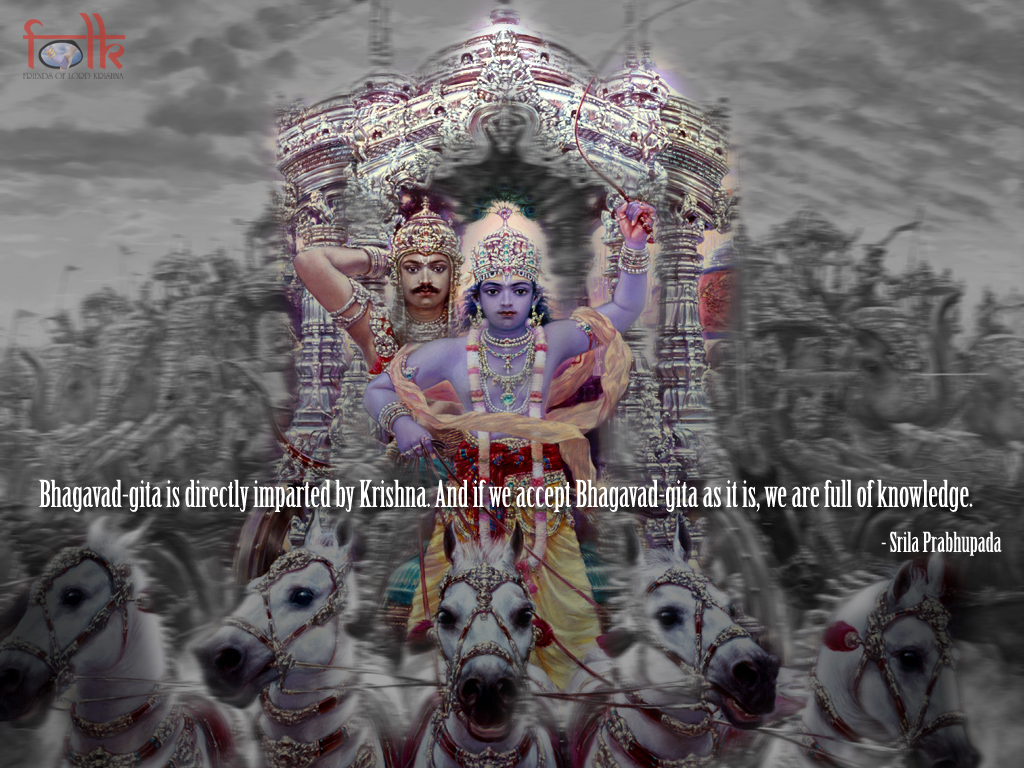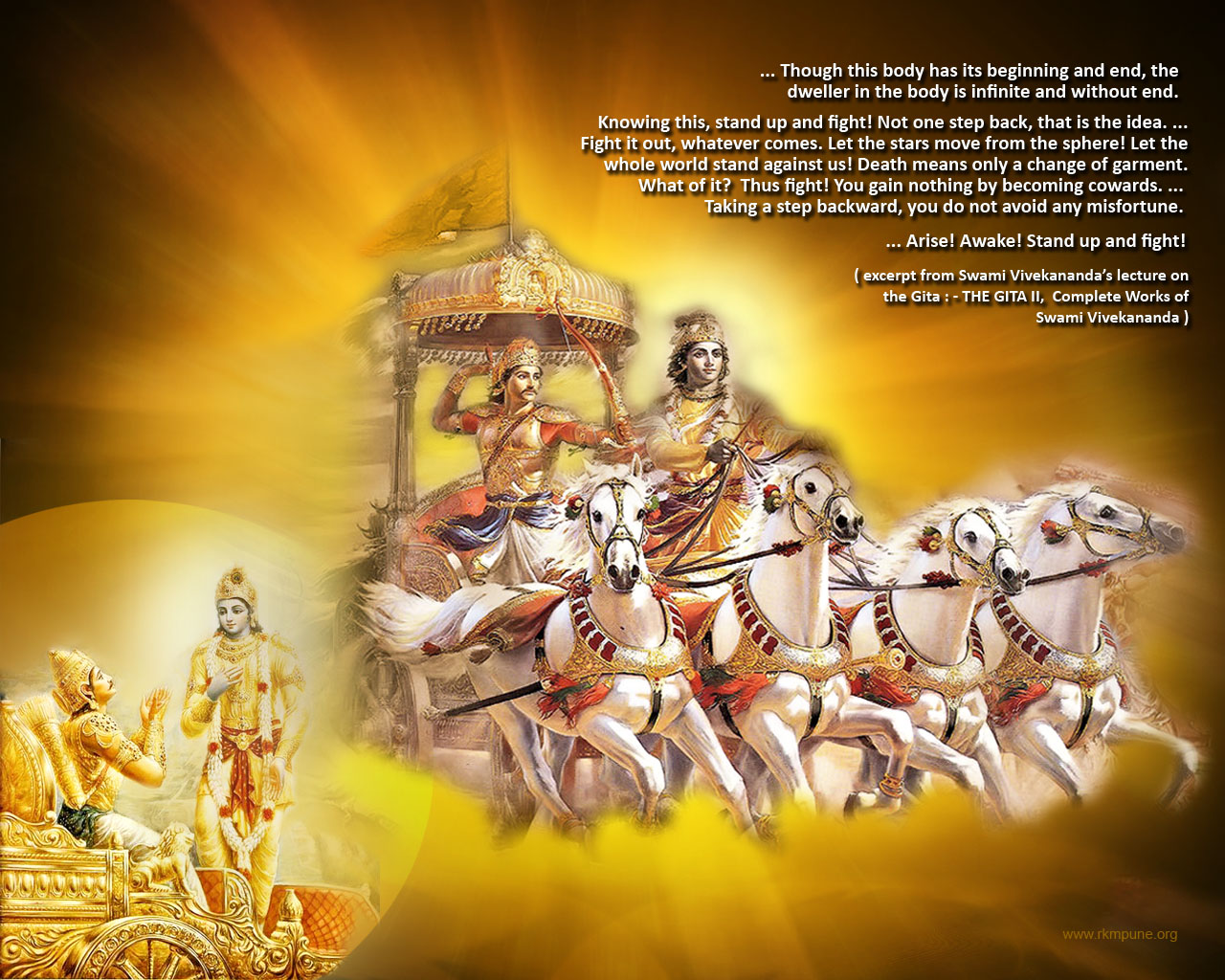The Bhagavad Gita is a Sacred and Ancient scripture of the Hindus, originating in the Indus Valley and Southern Asia. Many western minds that have thrown of the shackles and oppressive nature of Christianity have adopted Hinduism as their religion and way of life. Other western philosophies have been developed from the principles of the Hindu religion, Theosophy being one of them.
The History Channel on its Ancient Aliens series has mentioned the Bhagavad Gita in more than one episode.
One can listen to a Hindu Swami for hours and not get bored with the lessons, and unlike Christian preachers, they never yell at or threaten the audience.
This religion is far more suited to those spiritual persons that choose meditation as their communication with God.
The Bhagavad Gita, The Song of the Bhagavan, often referred to as simply the Gita, is a 700-verse scripture that is part of the Hindu epic Mahabharata. This scripture contains a conversation between Pandava prince Arjuna and his guide Lord Krishna on a variety of theological and philosophical issues.
Faced with a fratricidal war, a despondent Arjuna turns to his charioteer Krishna for counsel on the battlefield. Krishna, through the course of the Gita, imparts to Arjuna wisdom, the path to devotion, and the doctrine of selfless action. The Gita upholds the essence and the theological tradition of the Upanishads. However, unlike the rigorous monism of the mukhya, the earlier Upanishads, the Bhagavad Gita also integrates dualism and theism.
Numerous commentaries have been written on the Bhagavad Gita with widely differing views on the essentials, beginning with Adi Sankara’s commentary on the Gita in the eighth century CE and including Dnyaneshwari. Commentators see the setting of the Gita in a battlefield as an allegory for the ethical and moral struggles of the human life. The Bhagavad Gita’s call for selfless action inspired many leaders of the Indian independence movement including Mohandas Karamchand Gandhi, who referred to the Gita as his “spiritual dictionary”.
http://en.wikipedia.org
In the epic Mahabharata, Sanjaya, counsellor of the Kuru king Dhritarashtra, after returning from the battlefield to announce the death of Bhisma begins recounting the details of the Mahabharata war. Bhagavad Gita forms the content of this recollection. The Gita begins before the start of the climactic Kurukshetra war, where the Pandava prince Arjuna is filled with doubt on the battlefield. Realizing that his enemies are his own relatives, beloved friends, and revered teachers, he turns to his charioteer and guide, Krishna, for advice. Responding to Arjuna’s confusion and moral dilemma, Krishna explains to Arjuna his duties as a warrior and prince, elaborating on a variety of philosophical concepts.
Arjuna, one of the Pandavas
Krishna, Arjuna’s charioteer and guru
Sanjaya, counsellor of the Kuru king Dhritarashtra
Dhritarashtra, Kuru king.
Overview of chapters
The Bhagavad Gita is divided into eighteen chapters. The Sanskrit editions of the Gita name each chapter as a particular form of yoga. However, these chapter titles do not appear in the Sanskrit text of the Mahabharata. Swami Chidbhavananda explains that each of the eighteen chapters is designated as a separate yoga because each chapter, like yoga, “trains the body and the mind”. He labels the first chapter “Arjuna Vishada Yogam” or the “Yoga of Arjuna’s Dejection”. Sir Edwin Arnold translates this chapter as “The Distress of Arjuna”
Gita Dhyanam: (contains 9 verses) The Gita Dhyanam is not a part of the main Bhagavad Gita, but it is commonly published with the Gita as a prefix. The verses of the Gita Dhyanam (also called Gita Dhyana or Dhyana Slokas) offer salutations to a variety of sacred scriptures, figures, and entities, characterise the relationship of the Gita to the Upanishads, and affirm the power of divine assistance. It is a common practice to recite these before reading the Gita.
Arjuna–Visada yoga (The Distress of Arjuna contains 46 verses): Arjuna has requested Krishna to move his chariot between the two armies. His growing dejection is described as he fears losing friends and relatives as a consequence of war.
Sankhya yoga (The Book of Doctrines contains 72 verses): After asking Krishna for help, Arjuna is instructed into various subjects such as, Karma yoga, Jnana yoga, Sankhya yoga, Buddhi yoga and the immortal nature of the soul. This chapter is often considered the summary of the entire Bhagavad Gita.
Karma yoga (Virtue in Work contains 43 verses): Krishna explains how performance of prescribed duties, but without attachment to results, is the appropriate course of action for Arjuna.
Jnana–Karma-Sanyasa yoga (The Religion of Knowledge contains 42 verses): Krishna reveals that he has lived through many births, always teaching yoga for the protection of the pious and the destruction of the impious and stresses the importance of accepting a guru.
Karma–Sanyasa yoga (Religion by Renouncing Fruits of Works contains 29 verses): Arjuna asks Krishna if it is better to forgo action or to act (“renunciation or discipline of action”). Krishna answers that both are ways to the same goal, but that acting in Karma yoga is superior.
Dhyan yoga or Atmasanyam yoga (Religion by Self-Restraint contains 47 verses): Krishna describes the Ashtanga yoga. He further elucidates the difficulties of the mind and the techniques by which mastery of the mind might be gained.
Jnana–Vijnana yoga (Religion by Discernment contains 30 verses): Krishna describes the absolute reality and its illusory energy Maya.
Aksara–Brahma yoga (Religion by Devotion to the One Supreme God contains 28 verses): This chapter contains eschatology of the Bhagavad Gita. Importance of the last thought before death, differences between material and spiritual worlds, and light and dark paths that a soul takes after death are described.
Raja–Vidya–Raja–Guhya yoga (Religion by the Kingly Knowledge and the Kingly Mystery contains 34 verses): Krishna explains how His eternal energy pervades, creates, preserves, and destroys the entire universe. According to theologian Christopher Southgate, verses of this chapter of the Gita are panentheistic.
Vibhuti–Vistara–yoga (Religion by the Heavenly Perfections contains 42 verses): Krishna is described as the ultimate cause of all material and spiritual existence. Arjuna accepts Krishna as the Supreme Being, quoting great sages who have also done so.
Visvarupa–Darsana yoga (The Manifesting of the One and Manifold contains 55 verses): On Arjuna’s request, Krishna displays his “universal form” (Visvarupa), a theophany of a being facing every way and emitting the radiance of a thousand suns, containing all other beings and material in existence.
Bhakti yoga (The Religion of Faith contains 20 verses): In this chapter Krishna glorifies the path of devotion to God. Krishna describes the process of devotional service (Bhakti yoga). He also explains different forms of spiritual disciplines.
Ksetra–Ksetrajna Vibhaga yoga (Religion by Separation of Matter and Spirit contains 35 verses): The difference between transient perishable physical body and the immutable eternal soul is described. The difference between individual consciousness and universal consciousness is also made clear.
Gunatraya–Vibhaga yoga (Religion by Separation from the Qualities contains 27 verses): Krishna explains the three modes (gunas) of material nature pertaining to goodness, passion, and nescience. Their causes, characteristics, and influence on a living entity are also described.
Purusottama yoga (Religion by Attaining the Supremecontains 20 verses): Krishna identifies the transcendental characteristics of God such as, omnipotence, omniscience, and omnipresence. Krishna also describes a symbolic tree (representing material existence), which has its roots in the heavens and its foliage on earth. Krishna explains that this tree should be felled with the “axe of detachment”, after which one can go beyond to his supreme abode.
Daivasura–Sampad–Vibhaga yoga (The Separateness of the Divine and Undivine contains 24 verses): Krishna identifies the human traits of the divine and the demonic natures. He counsels that to attain the supreme destination one must give up lust, anger, greed, and discern between right and wrong action by discernment through Buddhi and evidence from the scriptures.
Sraddhatraya-Vibhaga yoga (Religion by the Threefold Kinds of Faith contains 28 verses): Krishna qualifies the three divisions of faith, thoughts, deeds, and even eating habits corresponding to the three modes (gunas).
Moksha–Sanyasa yoga (Religion by Deliverance and Renunciation contains 78 verses): In this chapter, the conclusions of previous seventeen chapters are summed up. Krishna asks Arjuna to abandon all forms of dharma and simply surrender unto him and describes this as the ultimate perfection of life.











Recent Comments